Wine Lister is experiencing a touch of Bordeaux fever. Having re-tasted Bordeaux 2016s in January, Wine Lister’s founder, Ella, attended BI Wines’ “10 years on” tasting last week, revisiting the iconic 2009 vintage.
As expected, the vintage yielded some truly exceptional wines, thanks to excellent weather conditions, especially around harvest time. However, some producers fell into the trap of waiting too long to pick, and high quality in 2009 is not a given. Ella has picked out 26 of the most successful examples of a unique and pleasure-giving vintage, hailing from across all of the best-known red wine Bordeaux appellations (N.B. no white wines were tasted).
The most heterogenous appellation was Saint-Emilion, with some wines rendered hot and hard by high alcohol, while those at the very top level were some of the best 2009s out there. Cheval Blanc, for example, achieved a “mystical, beguiling bouquet…like a magic potion”.
Pomerol did not seem to suffer from the heat in the same way, and made beautiful wines in 2009. Perhaps unsurprisingly, Le Pin garnered some exceptional comments, including “the richest, most decadent, abundant nose of the whole tasting”. Other Pomerol picks displayed an unusually dark-fruited character. Petrus (“not worn on the sleeve like the Le Pin”), had a “refined dark fruit character”, Hosanna “piercing damson fruit”, and La Conseillante boasted a “carnal, purple-fruit sweetness”.
On the left bank, Pessac-Léognan and Saint-Julien achieve joint-first place, earning five highlights each. Arguably the most impressive of these were La Mission Haut-Brion and Haut-Brion with the former described as “sensual, ethereal, and breath-taking”. Pape Clément showed almost “Rhône-esque animality”, while Malartic-Lagravière was “opulent” and “left you wanting more”.
Saint-Julien presented expected names – second growths Gruaud-Larose and Léoville Barton (described as “ultra-classical” and “thoroughbred” respectively), as well as a surprise in the form of Château Gloria, the only Cru Bourgeois to make it into this list of Bordeaux 2009 tasting highlights.
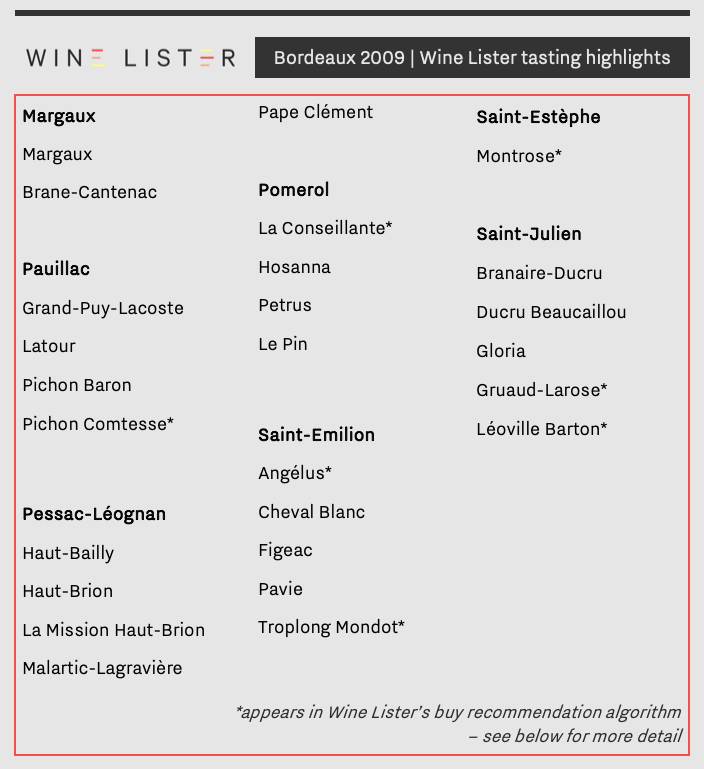
The remaining left bank appellations did not go wanting of favourites. Latour earned the comment, “impeccably turned-out, this wine demands attention”. Elsewhere in Pauillac Pichon Comtesse was “beguiling” and “gradually confident”.
In Margaux the appellation’s first growth namesake was hailed “quite the showstopper”, while Brane-Cantenac was “lifted, lovely, and luminous”. While Saint-Estèphe earned only one mention, its representative, Montrose surpassed expectation, appearing “supremely poised”.
All those wines marked “*” above currently qualify as Wine Lister “buy recommendations”. The Wine Lister team has been working hard to create a data-driven list of the ultimate best wines to buy – watch this space while we fine-tune the algorithm!
Other wines featuring in the Bordeaux 2009 highlights are: Grand-Puy-Lacoste, Pichon Baron, Haut-Bailly, Angélus, Figeac, Pavie, Troplong Mondot, Branaire-Ducru, and Ducru Beaucaillou.
Wine Lister Indicators are designed to help you find the perfect fine wine for any occasion. Wine Lister regularly tracks the movements of wines in and out of these segments (such as recent commentary featuring new Buzz Brands for Burgundy). This month we look at newcomers to the Value Pick segment – wines that achieve the best quality to price ratio.
France is the geographical victor of new Value Picks, with a total of seven wines hailing from Bordeaux and the Rhône (and one from the Loire). These traditional regions may appear “uncool” compared with the likes of Burgundy (whose popularity continues to rise). However, it is perhaps thanks in part to their “uncool” status that Bordeaux and the Rhône are also sources of exceptional value for money.
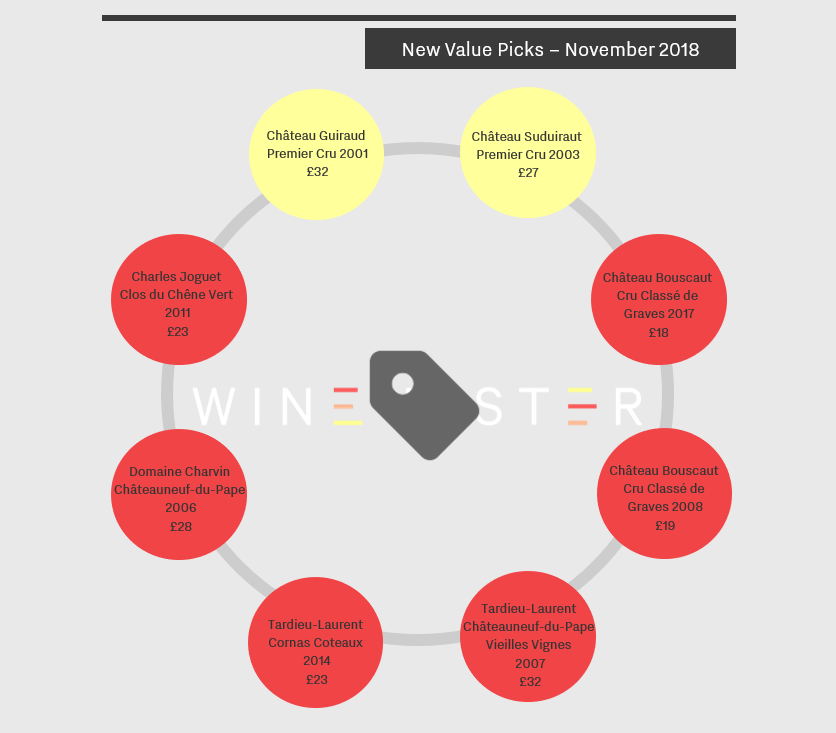
The only two whites of our new Value Picks, Château Guiraud Premier Cru 2001 and Château Suduiraut Premier Cru 2003, actually achieve the highest Quality scores of the group (936 and 929 respectively). Château Guiraud 2001 is priced at £32 per bottle in-bond, and Château Suduiraut 2003 at £27. Sadly, the incredible Quality scores of these Sauternes (as well as others across the board) may be hindered by a lack of demand for the volume produced. Sauternes typically earn poor Economics scores on Wine Lister (Château Guiraud 2001 achieves an Economics score of 212, and Château Suduiraut 2003 345), perhaps due to the pace at which older vintages of these exceptional sweet wines are consumed. With Christmas just around the corner, however, there is every reason to source either of these two for good value for your buck.
Elsewhere in Bordeaux, Pessac-Léognan rules the Value Pick reds with two listings from Château Bouscaut. The 2017 is one of Bouscaut’s new Value Pick vintages, however the real appeal, with 10 years of age, is the physical 2008 vintage, which achieves a Quality score of 768 (vs. 775 for 2017) for a price just £1 above the latest release (at £19 per bottle in-bond). These two vintages join existing Value Picks of Château Bouscaut, namely the 2016, 2015, 2013, and 2004. The latter is interestingly Bouscaut’s highest-scoring vintage ever (868), and therefore provides exceptional value at £21 per bottle in-bond.
In the Rhône, producer Tardieu-Laurent has two newcomers to the Value Pick segment: Châteauneuf-du-Pape Vieilles Vignes 2007 (£32) and Cornas Coteaux 2014 (£23), with Quality scores of 906 and 813 respectively. The Châteauneuf-du-Pape Vieilles Vignes now has an impressive six Value Pick vintages, and the Cornas Coteaux four. Indeed, Tardieu-Laurent (which was recently acquired by EPI, the owner of top Brunello producer Biondi-Santi and both Piper and Charles Heidsieck) appears a good producer to choose for value, with six of the domaine’s ten wines on Wine Lister having vintages in the Value Pick segment. It is perhaps therefore surprising that its Brand scores sit mostly in the average section of Wine Lister’s 1,000-point scale or below – uncool, but with very cool price to quality ratios.
A second Châteauneuf-du-Pape, the 2006 from Domaine Charvin is the third wine from the Rhône to make it to the list, with a Quality score of 869 and available at the modest price of £28 per bottle in-bond.
These French Value Picks convince us that “old-school” wines should not be dismissed as such. With an average price of £25 per bottle in-bond, and an average Quality score of 858, these represent excellent value for money – and that will always be cool.
As ripe, healthy grapes are being picked across Bordeaux, winemakers are anything but shy about the potential of the 2018 vintage. “2015 and 2016 are five-star vintages, but 2009 and 2010 are five-star plus,” said Olivier Bernard, president of the Union des Grands Crus Classés de Bordeaux. At his own property in Pessac-Léognan, Domaine de Chevalier, “2018 has 2009-2010 potential,” he declared on Wednesday morning, just as the red harvest was beginning.
Bernard is not the only Bordeaux producer daring to hope that the region has another great vintage on its way into the cellars. Part of the Wine Lister team is just back from four days in Bordeaux, where we visited châteaux on right bank and left, from Saint-Estèphe in the very north to Pessac-Léognan south of the city. We tasted lots of berries, spoke to oenologists, and even picked some grapes.
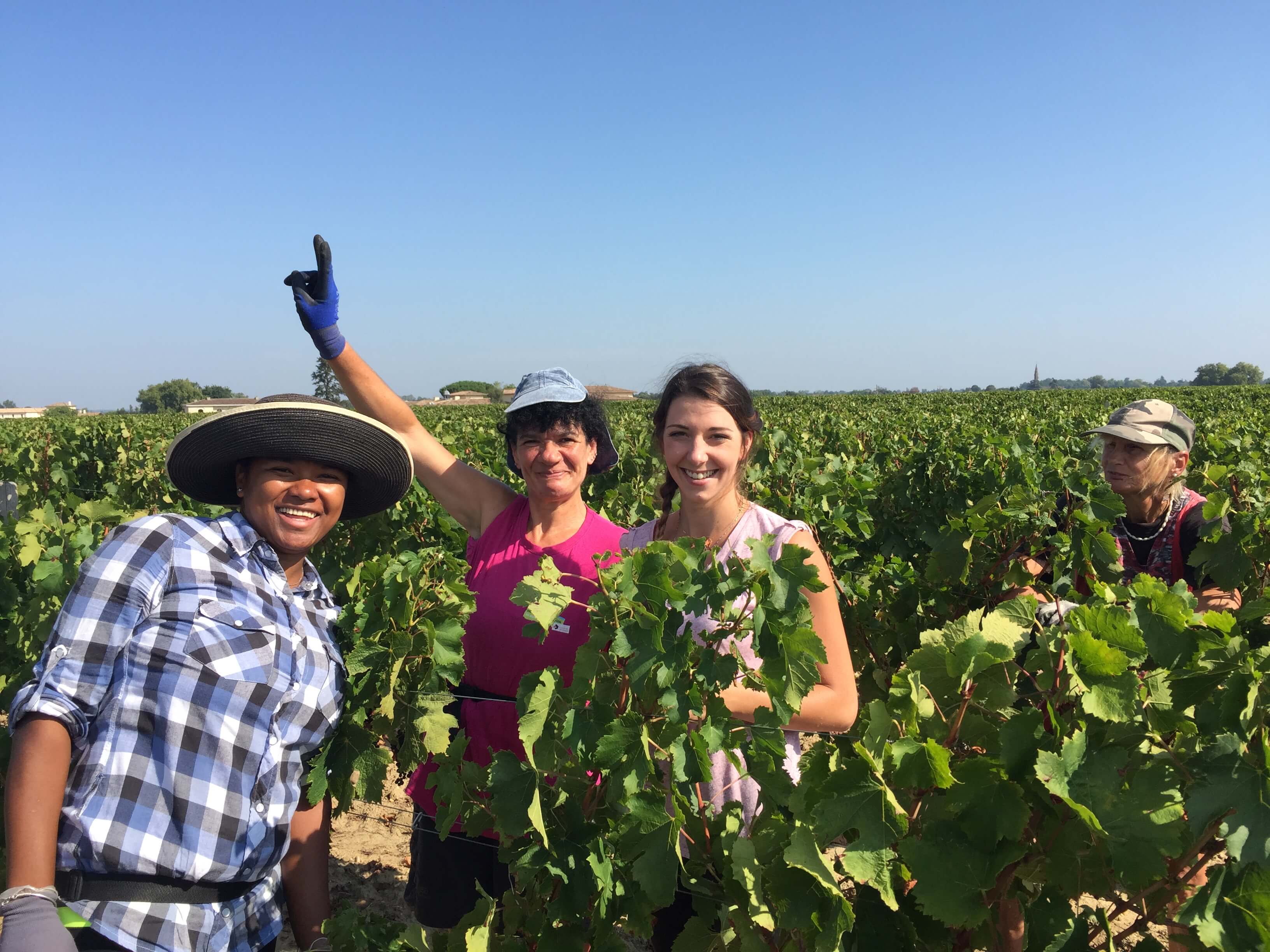
Members of the picking team at Petrus during the 2018 harvest
Producers’ smiles were big, and all the signs were promising, but after such a rollercoaster growing season, can 2018 really match up to the historic pair of 2009 and 2010? I asked straight-talking winemaking consultant Stéphane Derenoncourt if this comparison was justified. “More 2010,” he confirmed, adding, “There are going to be some delicious wines.”
Spring in Bordeaux was interminably wet, and mildew a serious threat throughout the region. “We thought there might not be a harvest at all,” recalls Nicolas Audebert, Managing Director of Châteaux Canon and Rauzan-Ségla. “It rained non-stop, and with high humidity and the high temperatures in June, it was almost tropical,” he said. Some members of Audebert’s team had never seen mildew so rife in 40 years of working the vines in Bordeaux.
Many top producers were affected, especially those practising organic or biodynamic viticulture and therefore unable to treat the vines systematically to protect from the fungus. In Saint-Estèphe, at the top of the Gironde Estuary nearest the Atlantic Ocean, Lafon-Rochet, organic since 2010 (though uncertified), abandoned the practice this year, and for good, in order to fight the rain.
However, mildew “is primarily a problem for quantity, rather than quality,” explained Axel Marchal, consultant and researcher at Bordeaux University, because the affected grapes are easily removed and discarded. “Badly hit vines can see a slight quality impact too, if the stress caused to the plant is enough to delay maturity,” he clarified.
At Canon in Saint-Emilion, quantity lost to mildew was recouped by less green harvesting later in the season. Its larger Margaux sister property, Rauzan-Ségla, was not so lucky, and yields will be lower than average. The two properties are organic (again not certified), allowing them to treat the vines when “really necessary”. However, many strictly organic or biodynamic estates will produce much smaller quantities of wine this year, meaning yields will be very varied from château to château, ranging from around 15 hl/ha to 50 hl/ha or more.
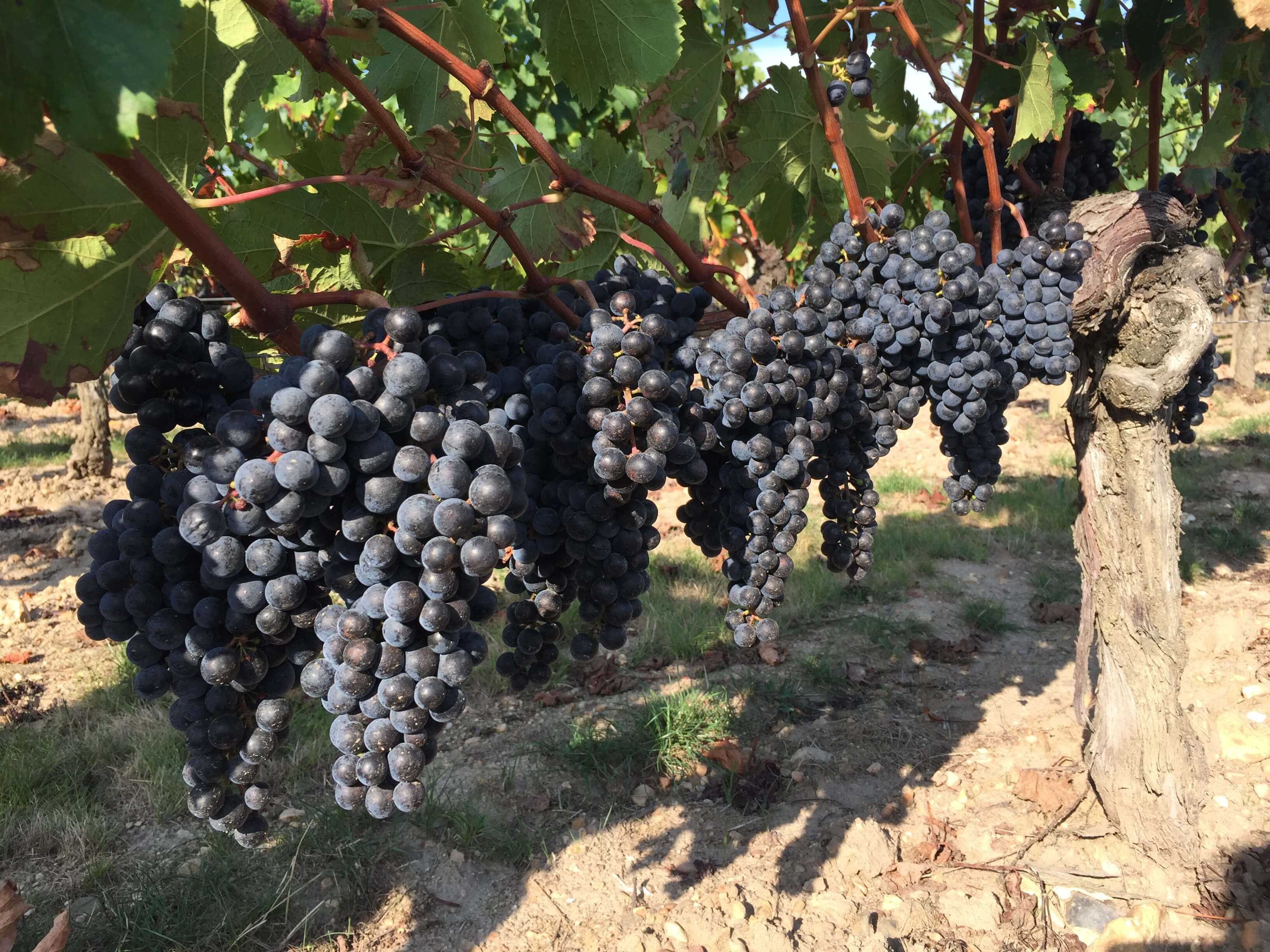
Grapes ripe for picking at Petrus
Potential quantity started off high, with the rain acting as “a signal for the plant to produce lots of fruit,” explained Bernard. The incessant spring downpours had another positive effect: they left the ground full of water, helping the vines to withstand the hot, dry summer that unfolded from 20th June onwards. “Looking at our vines, it’s hard to believe it’s been one of the driest summers in 50 years,” marvelled Bernard.
Audebert thinks the 2018 Canon will be soft and rounded, but livelier than 2005 or 2009, with phenolic potential above that of the 2010 (which of course is renowned for its intense colour and high levels of ripe tannin). When I asked if it could be as good as 2010, my question was met with silence and a roguish smile.
En primeur pricing is a crucial factor in the commercial success of top Bordeaux crus. With this in mind, Wine Lister has dedicated a section of this year’s Bordeaux study to the conundrum. We show historical pricing trends post release for a panel of 76 wines. The analysis indicates the effectiveness of release prices, based on the change between average ex-négociant release and current market prices (2009-2016 vintages):
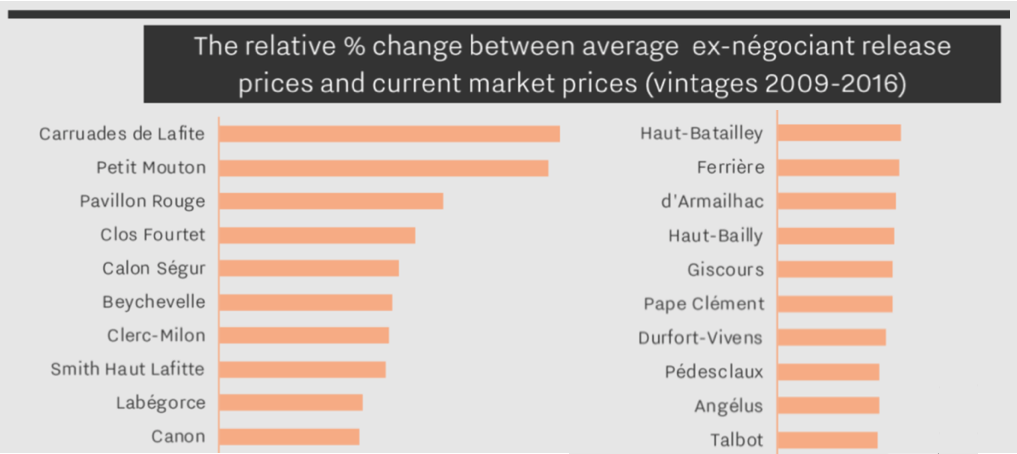
Above are the top 20 best-performing Bordeaux wines post en primeur release (to view the performance of all 76 wines, see page 14 of the Bordeaux study). The second wines of Lafite and Mouton have enjoyed the greatest gains in the marketplace, with Pavillon Rouge not far behind in third place.
Clos Fourtet is the best of the rest, followed by Calon Ségur, Beychevelle, Clerc-Milon and Smith Haut Lafitte. Lafite is the best-performing first growth, followed by Margaux and Mouton, with Haut-Brion making smaller gains.
This year’s en primeur campaign has not yet been met by the same enthusiasm as the 2016 or 2015 vintages. The average quality of 2017 is lower (by 10% if we take Wine Lister Quality scores for the same 76 wines) – a major factor in explaining price sensitivity, and why the average discount so far of 7% (9% excluding Haut-Batailley’s contrary price hike) is far from sufficient to oil the wheels of the campaign.
In our Bordeaux Market Study 2018, released just last week, we clarify an illustrative methodology for calculating release prices. Wine Lister looks at current market prices for similar recent vintages, and works backwards through three steps:
- Vintage comparison: As there is no obvious comparison for 2017, we apply the average quality to price ratio of the last nine vintages in order to arrive at a derived future market price, based on the average Wine Lister Quality score.
- Ex-château price: By removing the margins taken by the négociant and importer we reach the equivalent ex-château price.
- En primeur discount: Finally, we apply a discount of 10%-20% to incentivise buying en primeur, rather than waiting until the wine is physically available.
The chart below shows the theoretical application of this methodology to a basket of top wines. See page 13 of the Bordeaux study for a more detailed explanation.
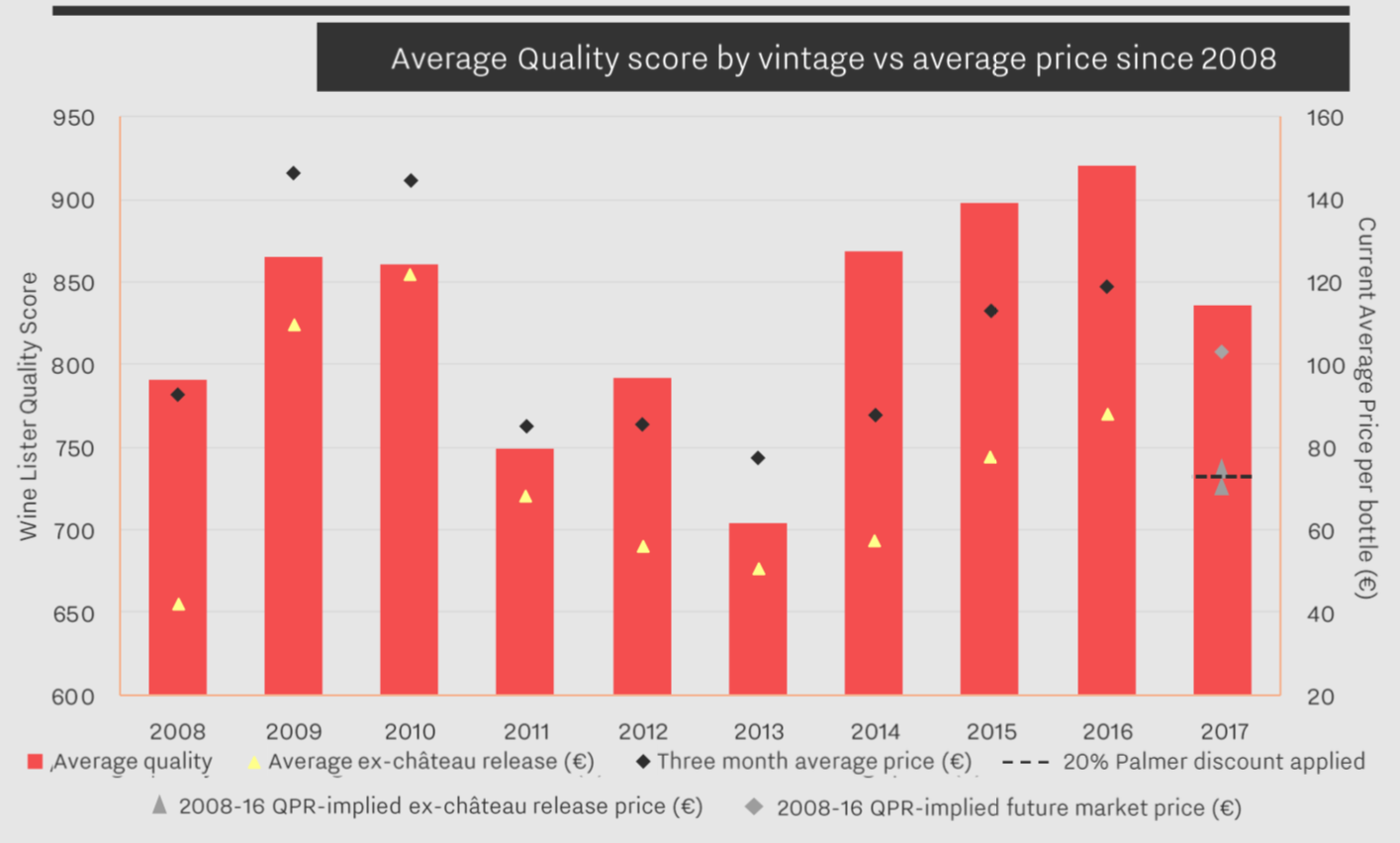
Prices released in the campaign thus far have varied from 20% discounts (Palmer, Domaine de Chevalier Rouge) to a 46% increase (Haut-Batailley) on last release prices.
Follow Wine Lister on Twitter for realtime en primeur release information, and use our dedicated en primeur page to compare 2017 release prices to last year.
Other wines featured in the top 20 best-performing Bordeaux post en primeur release are: Labégorce, Canon, Haut-Batailley, Ferrière, d’Armailhac, Haut-Bailly, Giscours, Pape Clément, Durfort-Vivens, Pedesclaux, Angélus, and Talbot.
Subscribers can download a copy of the full Bordeaux Study 2018 from the analysis page.
As we outlined in our introduction to the vintage, Bordeaux 2017 eludes generalisation. Striking arbitrarily, the late April frost resulted in a heterogenous Bordeaux vintage in terms of both volumes and quality.
Ahead of the official release of Wine Lister’s latest Bordeaux Market Study tomorrow (don’t forget to subscribe to secure full access, via the Analysis page)*, here we give you a preview of the top 20 Quality scores for Bordeaux 2017. Wine Lister’s Quality scores for Bordeaux 2017 are based on the recently-released scores for four of our five partner critics** – Jancis Robinson, Bettane+Desseauve, and Vinous’ Antonio Galloni and Neal Martin – as well as a small weighting for longevity:
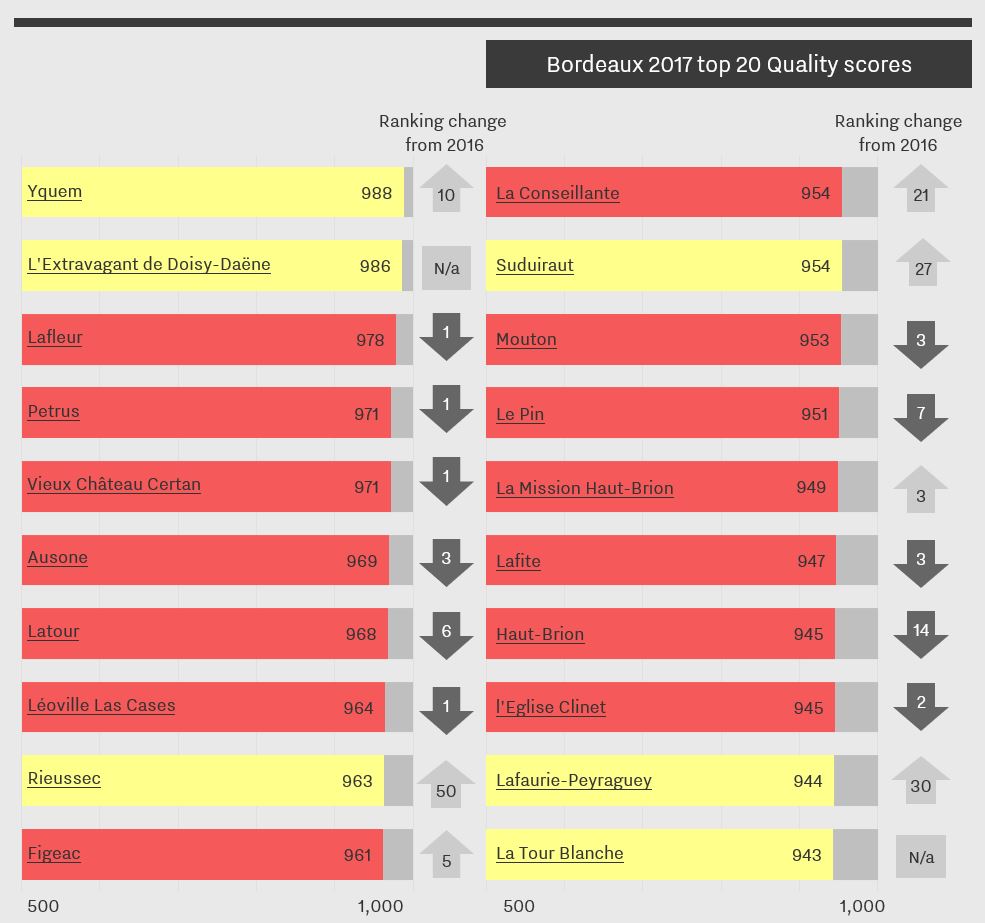
The frequent flashes of yellow in the chart above are testament to the kindness of the 2017 vintage to Bordeaux’s sweet whites, with Yquem and L’Extravagant de Doisy-Daëne achieving first and second places (scoring 988 and 986 respectively). Other sweet wines, Rieussec, Suduiraut, and Lafaurie-Peyraguey make some of the largest gains on their 2016 positions. Sauternes & Barsac stand out as the only appellations whose combined 2017 Quality score is above that of the 2016 (up 21 points).
When it comes to reds, the right bank fares best, and is home to seven of the vintage’s top 10 wines, five of them from Pomerol. Lafleur is the top-scoring red (in third place overall) with a Quality score of 978, followed by Petrus and Vieux Château Certan on 971 apiece. Pomerol’s La Conseillante makes the largest strides of any red wine in the top 20, up 21 places since 2016.
Overall, Pomerol is the highest-scoring appellation of the vintage, with an average Quality score of 959 (nonetheless down 25 points from 2016).
The left bank has fared less well with two of the five left bank appellations seeing score decreases of c.10% (Margaux and Saint-Estèphe, achieving 850 and 829 respectively). Despite dropping six places – from the top spot last year – Latour wins the left bank crown, followed by consistent overperformer Léoville Las Cases.
Other wines featuring in the top 20 Bordeaux 2017 Quality scores are: Ausone, Figeac, Mouton, Le Pin, La Mission Haut-Brion, Lafite, Haut-Brion, l’Eglise Clinet, and La Tour Blanche. You can view Quality scores for wines outside the top 20 here.
*Now published: for more analysis of the 2017 vintage, subscribe to read our Bordeaux Study.
**Jeannie Cho Lee was unfortunately unable to travel to Bordeaux to taste this year.
While the wine world lives and breathes Bordeaux during this year’s en primeur season, Wine Lister looks at some high-scoring Bordeaux reds that could easily be overlooked amidst the sea of releases to choose from across Médoc classified growths and beyond. Below we examine the top five fourth growths by overall Wine Lister score.
The highest-scoring Bordeaux fourth growth on Wine Lister is Château Beychevelle, with a score of 879. Its trailing Quality score of 790 is boosted by Brand and Economics scores of 980 and 904 respectively. Meanwhile, Beychevelle’s 2016 and 2015 vintages achieve Quality scores more than 15% higher than its wine-level average. It will be interesting to see how the 2017 vintage (with a Quality score of 805 thus far, based on partner critics Bettane+Desseauve, Neal Martin and Julia Harding MW for Jancis Robinson) is priced during this year’s en primeur campaign in the coming weeks.

In second and third place are Château Talbot and Château Branaire-Ducru, achieving Wine Lister scores of 859 and 842 respectively. Talbot is the most popular of the five, receiving 14,602 searches each month on Wine-Searcher, resulting in the group’s best Brand score (983). Talbot’s position as a ubiquitous Bordeaux brand is no doubt helped by a production level of c.400,000 bottles per annum – over twice as many as Branaire-Ducru.
The fourth entry and only Pauillac to feature, Duhart-Milon, has the lowest Quality score of the five (752), but carries a Brand score of 916 points. It is no surprise that, as part of the Lafite group, it is the most-traded Bordeaux fourth growth at auction, its top five vintages having traded 1,186 bottles over the past four quarters.
Finally, Lafon-Rochet appears in the Listed blog for the second week in a row (previously featuring in the top five Saint-Estèphes by Economics score). At 800 exactly, Lafon-Rochet’s Wine Lister score is safely in the “very strong” category on the 1,000-point scale. In the context of this week’s top five it has the third-highest Quality score (770), but its price per bottle is 41% below the rest – a savvy buy!
Bordeaux 2017 en primeur scores are now out from Neal Martin for Vinous.com – our US partner critic, and one of the most prominent voices of international wine criticism today. (Antonio Galloni’s scores are due out this Thursday, 3rd May). This is the first time Wine Lister has featured Neal Martin’s scores after he joined Vinous in February this year. Below are his scores equal to or above 94-96:
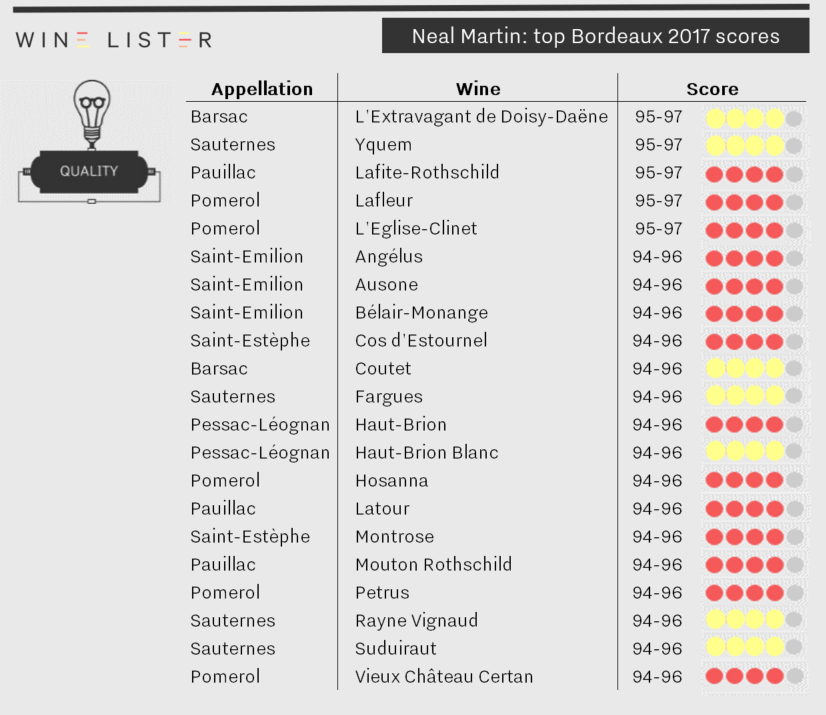
No wines earned perfect scores this year (in contrast with 2016, where Martin awarded a potential 100 points to eight wines), with five wines achieving Martin’s highest potential score of 97.
With a score of 95-97, Yquem sits in the top score bracket for the third time, already awarded 18.5 and 19.5-20 by Julia Harding MW (on behalf of Jancis Robinson) and Bettane+Desseauve respectively.
Similarly to Bettane+Desseauve, Martin’s appreciation for the quality of Sauternes and Barsac in 2017 is clear, with five other sweet whites making his top 21 (L’Extravagant de Doisy-Daëne, Coutet, de Fargues, Rayne Vignaud, and Suduiraut).
Lafite is Martin’s highest scoring Médoc first growth, which he describes as “classic from start to finish”. Joining the high rankings are first growths Haut-Brion (and its white), Latour, and Mouton, all earning 94-96 points.
The right bank figures strongly too. Two Pomerols (Lafleur and L’Eglise-Clinet) equal Lafite’s score, with three more earning 94-96, alongside three wines from Saint-Emilion. Ausone, like Yquem, makes its third appearance in top scores for Bordeaux 2017 from Wine Lister partner critics. “What a great Ausone this is destined to be,” comments Martin.
Bélair-Monange is perhaps the stand-out entry, described by Martin as, “the jewel in the crown of J-P Moueix… an assured, and bewitching Saint-Emilion”.
Other wines scoring 94-96 from Neal Martin include: Angélus, Cos d’Estournel, Hosanna, Montrose, Petrus, and Vieux Château Certan.
All these scores are now live on the wine pages of our website for subscribers to view (alongside those of Bettane+Desseauve and Julia Harding), with links through to Neal Martin’s tasting notes on Vinous.com. Read Neal Martin’s coverage of Bordeaux 2017 here.
Vinous coverage will be completed by Antonio Galloni’s scores, due for release on Thursday 3rd May.
Bordeaux 2017 en primeur scores are now out from Julia Harding MW for JancisRobinson.com – our UK partner critic (Jancis Robinson herself was kept in London updating the World Atlas of Wine for its next, eighth edition).
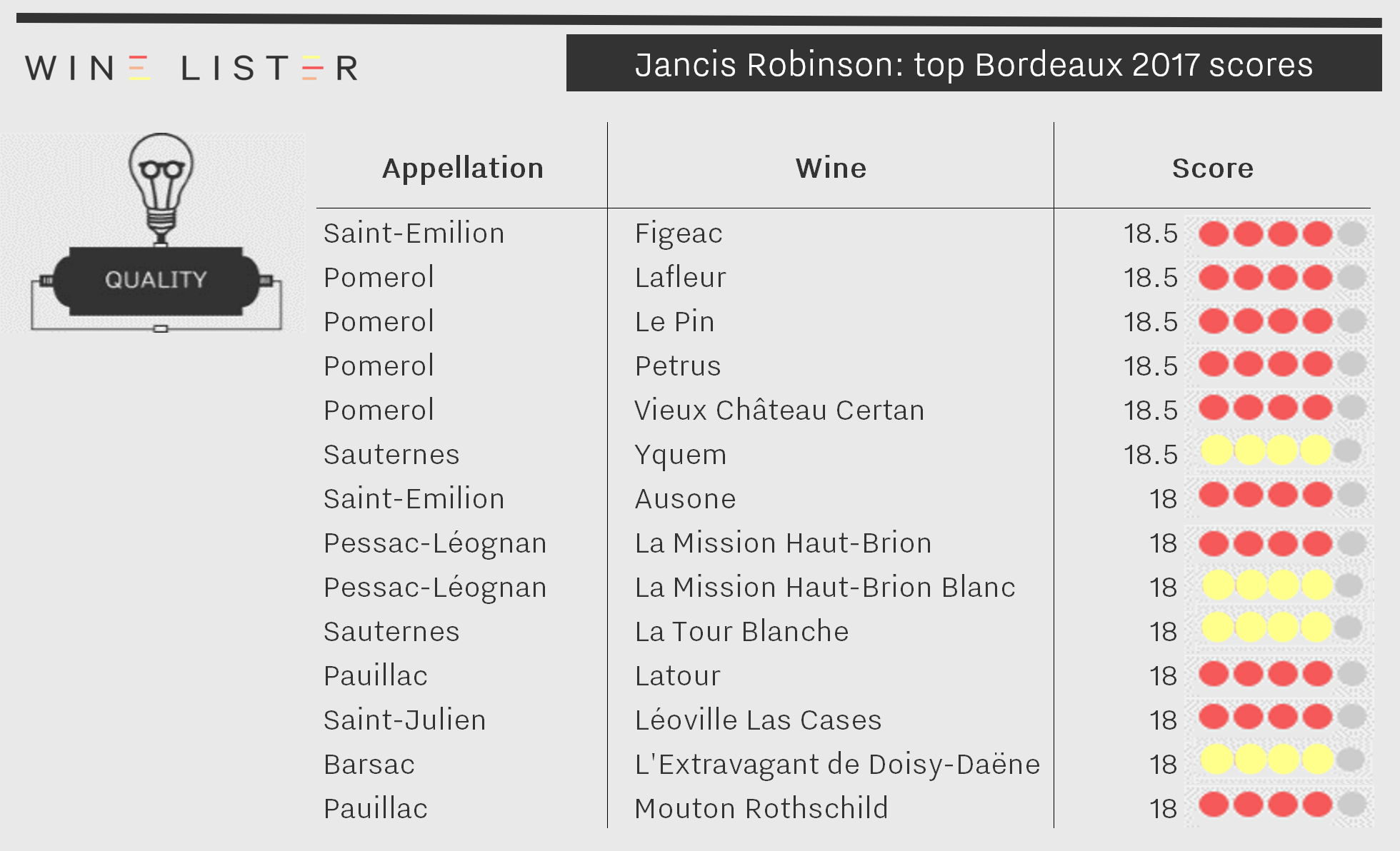
Harding awarded 14 wines a score of 18 or above, with Pomerol the most featured appellation at the top of her scoreboard. Lafleur, Le Pin, Petrus, and Vieux Château Certan all scored 18.5, the highest score given by Harding to any Bordeaux 2017 (while last year Robinson granted seven 2016 Bordeaux 19 points, including four of Harding’s favourites this year).
This Pomerol quartet is joined by another right bank wine, Saint-Emilion Premier Grand Cru Classé B, Figeac, whose tasting note from Harding ends: “Silky, charming, mouth-watering. So succulent, so precise, unforced.”
The only other wine to score 18.5 is the king of Sauternes, Yquem. As we saw in yesterday’s blog summing up Bettane+Desseauve’s top scores, 2017 is successful vintage for sweet whites. Harding’s top wines include La Tour Blanche and Doisy Daëne’s tiny production Barsac – already released at £140 per half bottle – L’Extravagant.
Like our French partner critics, Harding also gives high scores to Ausone, Latour, La Mission Haut-Brion Rouge, and its white sibling – the only dry white in her top table. Mouton Rothschild and Léoville Las Cases also score 18 points.
All these scores are now live on the wine pages of our website for subscribers to view (alongside those of Bettane+Desseauve), with links through to Harding’s tasting notes on JancisRobinson.com. Read Jancis Robinson’s extensive Bordeaux 2017 coverage here.
Neal Martin’s and Antonio Galloni’s scores will be added on Tuesday and Thursday respectively.
Bettane+Desseauve – Wine Lister’s French partner critics – have released their en primeur scores for the 2017 Bordeaux vintage. Here is a glimpse of their top-scoring wines:
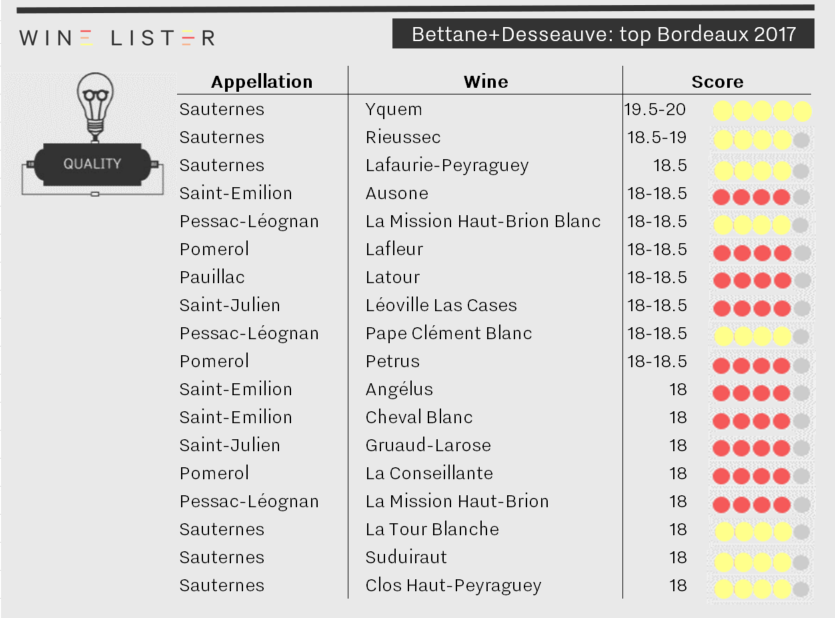
Château d’Yquem is the only potentially perfect wine of the vintage for the French duo. “Another legend ending in 7, worthy of the 1967, but more pure, and the sublime 1937 and 1947 too,” muses the encyclopaedic Michel Bettane.
Yquem was the only white wine to make an appearance in Bettane+Desseauve’s top 2016 Bordeaux, but this year has been joined by a host of other Sauternes (Rieussec, Lafaurie-Peyraguey, La Tour Blanche, Suduiraut, and Clos Haut-Peyraguey), in a vintage which Bettane has marked out as “favourable for the entire Haut-Sauternes sector”.
Two dry whites also broke the 18-point mark: La Mission Haut-Brion Blanc and Pape-Clément Blanc, painting the top of the scoreboard unprecedentedly yellow.
As for reds, taking more of a backseat than usual, the right bank dominates, with three out of the four Saint-Emilion Grands Crus Classés A scoring 18 (Angélus and Cheval Blanc) or above (Ausone). By contrast only one Médoc first growth – Latour – reaches the 18-point mark.
Joining Ausone and Latour with 18-18.5 are Lafleur, Léoville Las Cases, and Petrus. Our CEO, Ella, tasted Petrus twice – first for a sneak preview with Thierry Desseauve and her father, and then with the Wine Lister team three days later. She is not surprised to see it come out among the top five reds of the vintage, and it must run in the family, because Petrus was also Pa Lister’s favourite.
Bettane+Desseauve’s top table sees standout scores of 18 apiece granted to La Conseillante and Gruaud-Larose. And that in a year where fewer high scores were given in general; 16 2016s scored a straight 19 or above last year, compared to just one in 2017.
“I can’t see it being a big campaign.” That is the view of Serena Sutcliffe, Honorary Chairman of Sotheby’s Wine, echoed by some on the Place de Bordeaux. The usually upbeat Mathieu Chadronnier, Managing Director of négociant CVBG, asserts that 2017 Bordeaux en primeur “will be a weak campaign compared to last year”.
This sentiment is also recognised in the semi-official line, from Emmanuel Cruse, Grand Maître of the Commanderie du Bontemps, Médoc, Graves, Sauternes, and Barsac. “We all know that over the weeks to come the distribution of this vintage could be slightly more difficult on the commercial side than previous ones,” he accepted, adding reasonably, “We need to recognise that each vintage has its fair price.”
The general (if not unchallenged) consensus is that prices will come down on 2016. “Of course they will,” said Chadronnier, “but not enough.” “We always wait for decreases and they’re never considered enough,” he continued, then asking, rhetorically, exasperated, “what is enough?”
What is enough indeed? Perhaps more than ever before, there is no one size fits all formula. Just as quality and style vary from château to château in 2017 (see part I of our en primeur round-up), so will pricing. Each property has its own brand trajectory, 2017 vintage quality, volume considerations, and price positioning history. This has been epitomised by the wildly different approaches of the first two major releases of the campaign, Palmer and Haut-Batailley.
Only a small group of wines can get away with staying around 2015 prices (15-25 according to one Bordeaux courtier). Even fewer, if any, can maintain their 2016 release price. Contenders are arguably the big success stories of the 2016 en primeur campaign. According to Wine Lister’s Founding Members (c.50 key members of the international fine wine trade), first growths aside, these were Châteaux Lynch-Bages, Canon, Calon Ségur, Figeac, Pichon Comtesse, and Montrose.

However, when we put it to some of these producers that they were among a happy few potentially in a position to maintain 2016 prices, most dismissed the idea. “I could even go up and people would buy it,” mused Laurent Dufau, Managing Director of Calon Ségur. “But I won’t”, he concluded, adding “I would rather maintain the trade’s goodwill”. Nicolas Glumineau, Managing Director of Pichon Longueville Comtesse de Lalande, replied firmly, “If the question is will the price be like 2016, the response is evidently not”. He continued, “I’m really very happy with the wine we’ve made, but it’s not the 2016”.
In fact, almost every château we spoke to in Bordeaux said it would reduce the price. “It would not be right to release the 2017 at the same price as the 2016,” said Jean-Valmy Nicolas, Co-Managing Director of Château La Conseillante. “In my opinion our pricing strategy should be based on relative quality, not relative volume,” he said, referring to the impact of the frost on production volumes (down 15% on 2016).
As much as anything else, most Bordelais won’t risk the reputation of the 2016s. For most, following significant price increases for the 2016 vintage, a decrease for 2017 is manageable. This was precisely Edouard Moueix’s point (Managing Director of négociant Jean-Pierre Moueix) when he lamented, “People always compare to the year before, so even if there’s a 10-15% decrease on 2016 it’s still too high.”
For a handful of properties whose 2015s and 2016s were relative bargains, bringing the price down too much in this vintage is going to be a harder pill to swallow. Problematically for them, the market does still think in terms of increase or decrease on the previous vintage, even if this is an overly simplistic approach.
“I don’t believe for a second that prices will go down,” declared Nicolas Audebert, Managing Director of Châteaux Canon and Rauzan-Ségla, two of Bordeaux’s rising stars. Canon was voted the fifth most successful release of last year’s en primeur campaign. This is thanks to the combination of its rising popularity and its reasonable 2016 release price – it sold like hotcakes. Its 2016 price has risen by 23% since release, so arguably it is one of the very few wines that could conceive of not decreasing its price this year.
The only other château to suggest that a price decrease was by no means a given was Cos d’Estournel. Faced with the generalisation of 2017 as below the level of the last two vintages, owner, Michel Reybier, told us that “for us, compared to 2016, the 2017 vintage might even be better.”
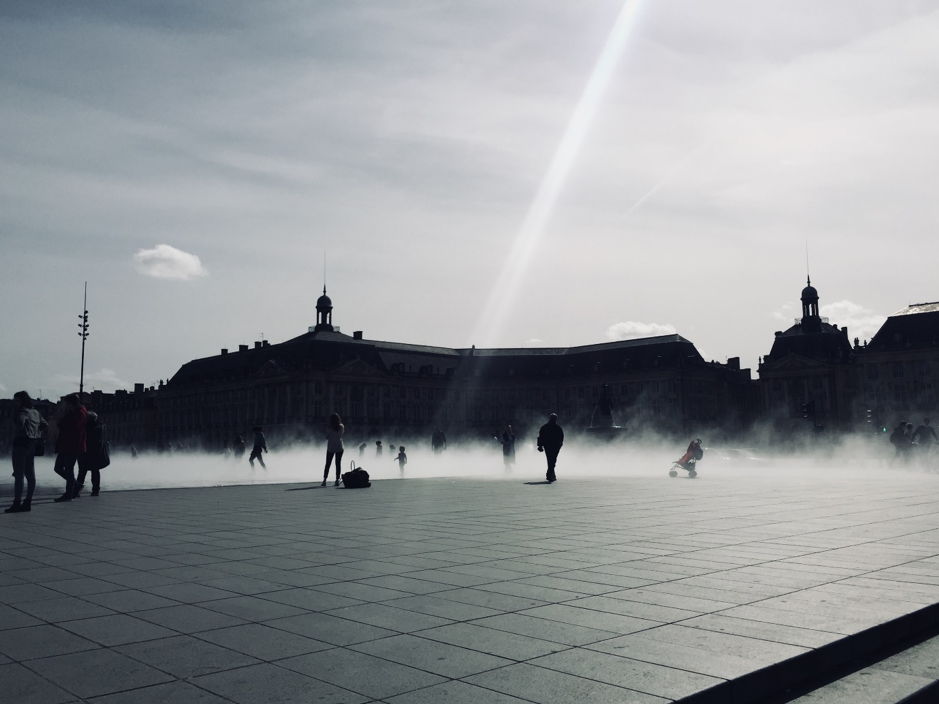
Smoke and mirrors: Bordeaux’s Miroir d’eau (water mirror) on the only sunny day of Wine Lister’s en primeur tasting trip. Photo © Ella Lister
Farr Vintners summed up their thoughts on pricing succinctly, saying “if prices are at around the current market for [2014, 2013, 2012 and 2011], 2017 starts to look very interesting,” cautioning, “at close to current 2016 or 2015 prices the wines will not be worth buying.” Will the threat of not selling be enough to moderate producers’ pricing ambitions?
“They couldn’t care less whether they sell,” said the car hire attendant who rented me my car at Bordeaux airport. If the news has spread that far out of the wine industry, maybe it’s true. Certainly, for a gilded group of crus classés the idea of keeping back stock and selling it for more down the line is appealing. And for what they do release, they can be pretty certain their négociants will back them up and carry the stock (and the risk), even if there are few end buyers.
This was confirmed by one large négociant, who told us off the record, “We’ll buy but we won’t sell as much as we want to.” He is “worried about prices,” citing “the usual Bordeaux spiral.” He was referring to the transition period required after a string of good vintages, during which prices are not recalibrated sufficiently. “Châteaux sold the wine last year, everyone’s happy, so they won’t come down enough,” he concluded.
As for timing, we’ve already seen important releases this week, earlier than expected, with Palmer coming out a day earlier than Cos d’Estournel’s surprise release last year, in spite of the tastings taking place a week later. Nonetheless, a long campaign is expected, in part due to an inordinate number of bank holidays in May (in France and the UK). Philippe Dhalluin, Managing Director at Mouton Rothschild, seemed to predict this when he told us “it is not a speculative campaign so it should start off quite quickly.” He added, “We’d like to have an early campaign but May is complicated,” specifying, “I’d like to release before Vinexpo – it’s possible.” Anything is possible in love and en primeur.
Follow us on Twitter and on the blog for real-time coverage of the Bordeaux 2017 en primeur campaign. Check www.wine-lister.com next week for a new dedicated en primeur page where you can find out everything you need to know during the campaign.












